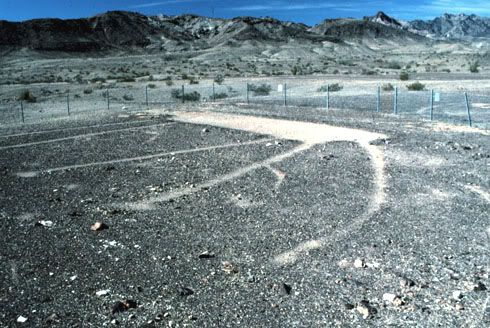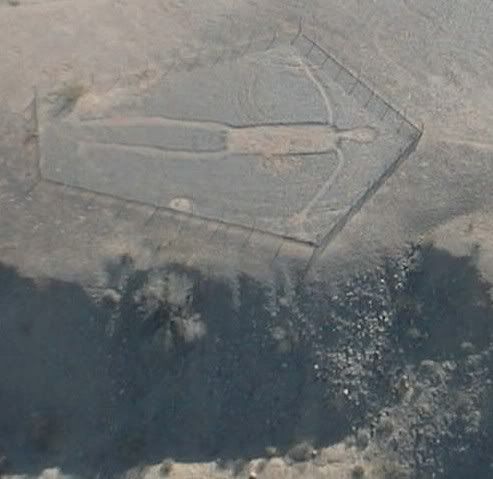( – promoted by navajo)
On a terrace above the Colorado River just north of Blythe, California there is a 170-foot tall human figure which has been carved into the desert. The human figure is facing north and is accompanied by another 60-foot tall giant facing south with a spiral design. These images were first discovered by non-Indians when a pilot flying over the area notices them in the late 1920s.
Throughout the desert areas of the American Southwest there are more than 600 known geoglyphs: earthen images which were made by scraping away the stable dark desert pavement to reveal the lighter soil underneath (these are also called intaglios or engravings) or by placing boulders and/or large cobbles to form figures. Geoglyphs provide images of giants, animals, mythic figures, and geometric designs.
Some of the better known geoglyphs include the following:
Fisherman:
This geoglyph is located near Quartsite, Arizona. It is an intaglio forms a fisherman holding a spear overhead while two fish swim below. This is probably an image of Kumastamho, the Quechan creator spirit who carved the course of the Colorado River with his spear.
To the south of the Fisherman is a group of 14 intaglios, including one which is a giant arrow which points to the Fisherman several miles away.
Running Man:
This geoglyph is located on an ancient shoreline of Searles Lake in the Mojave Desert of California. This 9-foot tall figure was formed with cobbles.
Giant Snake:
The desert pavement east of Parker, Arizona was scraped away to form a huge snake figure. The snake’s eyes were formed by the placement of two large granite cobbles.
Blythe Itaglios:
There are six figures in three different locations along a ritual pilgrimage trail used by the Yuman-speaking people. The figures illustrate the story of creation and are used to keep the story alive. The figures include a human and a cougar.
Trail of Dreams:
This is both a mythical trail and an actual trail which extends along the Colorado River from Newberry Mountain in Nevada to Pilot Knob Mountain in Arizona. All along this trail there are geoglyphs which recreate the stories associated with the trail.
Some conclusions:
Geoglyphs are difficult for archaeologists to date. However, some new dating techniques have been applied to the Running Man figure and suggest that it was made more than 6,000 years ago. Other figures in California’s Panamint Valley have been dated to 12,000 years ago. However, many of the figures along the Colorado River have been made only within the last 500 years.
The fish swimming underwater at the feet of the Fisherman is now estimated to have been made about 1540 AD and is felt to be younger than the image of the Fisherman.
Understanding the meaning of the geoglyphs may be more difficult than dating them. They are symbols, but these symbols can only be understood from the context of the culture which created them. It is impossible to accurately talk about what these geoglyphs mean without consulting people who are familiar with the cultures that created them.
Among the Yuman-speaking people along the Colorado River, the power for success as a warrior, shaman, singer, or chief comes from dreams rather than from formal training or learning. One of the ways of creating a stronger connection between the dreamer and the spiritual power of the vision is to bring it to life through a geoglyph. Many geoglyphs can be best explained as forms of spiritual art, as a way of enhancing spiritual power and understanding.
Some of the geoglyphs, such as that of the Fisherman, illustrate important places and events in creation. These are not images which have been forgotten by Indian people: archaeologists who have been studying the figures have noticed that the figures continue to change indicating that they are still being used ceremonially.
In recent times, many of the geoglyphs have been destroyed or damaged. Some of this has been the intentional work of vandals, while others have been destroyed by people in off-road vehicles who drive over the geoglyphs. In an effort to protect some of the geoglyphs, the Bureau of Land Management (BLM) has fenced some of them on the lands which it manages. The fencing does stop damage by off-road vehicles, but does not appear to interfere with continued ceremonial and spiritual use of the figures.
There are some “New Age” non-Indians, inspired by fantasies of master races from other galaxies, who would like to attribute the geoglyphs to visitors from other worlds, a kind of interplanetary graffiti signaling to passing space ships. Attributing the construction of geoglyphs to people from other planets is reminiscent of the 1800s when many non-Indians felt more comfortable explaining the construction of the “mounds” in the mid-west, such as those of Cahokia, to either the Aztecs or to some vanished race of super-humans. The denial of Indian heritage and of Indian achievements may be considered to be a form of racism. The reality is, of course, very different. Geoglyphs were made by Indian people.


Leave a Reply